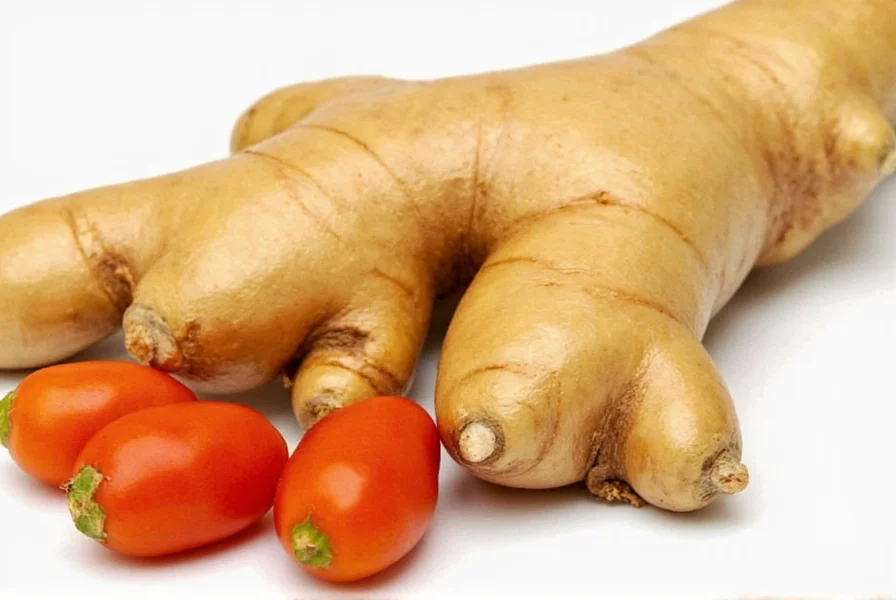Ginger has been prized for thousands of years across Asian and Middle Eastern cultures, not just for its distinctive flavor but for the unique spicy sensation it delivers. While many assume all spicy foods work the same way, ginger's heat operates through a fascinating biochemical process that differs significantly from what you experience with chili peppers.
The Biochemistry Behind Ginger's Signature Heat
At the heart of ginger's spiciness lies a group of compounds called gingerols, with 6-gingerol being the most abundant and potent. These phenolic compounds interact with your sensory system in a specific way:
| Spicy Compound | Found In | Receptor Targeted | Sensation Profile |
|---|---|---|---|
| Gingerol | Fresh ginger | TRPV1 (partially) | Sharp, warming, aromatic |
| Shogaol | Dried/processed ginger | TRPV1 (more strongly) | Hotter, more pungent |
| Capsaicin | Chili peppers | TRPV1 (fully) | Burning, intense heat |
When you bite into fresh ginger, 6-gingerol binds to transient receptor potential vanilloid 1 (TRPV1) receptors on your tongue and in your mouth. These receptors normally respond to heat (above 43°C/109°F) and acidic conditions, signaling potential tissue damage. Gingerol tricks these receptors into activating without actual heat, creating that characteristic warming sensation.
Why Ginger's Spiciness Differs From Chili Peppers
Many people wonder why is ginger spicy but doesn't burn like chili peppers. The key difference lies in how gingerol interacts with TRPV1 receptors compared to capsaicin:
- Gingerol only partially activates TRPV1 receptors, creating a milder, more transient sensation
- Capsaicin fully saturates these receptors, causing prolonged burning
- Ginger's spiciness often comes with aromatic compounds that create a complex flavor profile
- The burning sensation from ginger typically fades faster than chili heat
This partial activation explains why you can consume relatively large amounts of ginger without the overwhelming heat that even mild chili peppers might deliver. The sensation is more of a sharp warmth that enhances other flavors rather than dominating them.
How Processing Changes Ginger's Spiciness
What makes ginger spicy actually transforms when ginger is processed. Fresh ginger contains mostly gingerols, but when ginger is dried, cooked, or stored, these compounds dehydrate to form shogaols:
Shogaols are approximately twice as pungent as gingerols, which explains why dried ginger powder often tastes significantly hotter than fresh ginger root. This chemical transformation also creates zingerone, a compound with a warmer, sweeter spiciness that becomes more prominent when ginger is cooked.

Evolutionary Purpose of Ginger's Spiciness
From an evolutionary perspective, why does ginger taste spicy? The spiciness serves as a natural defense mechanism for the ginger plant. Gingerol and related compounds deter herbivores and pests from consuming the rhizome (the underground stem we harvest as ginger).
Interestingly, humans appear to be among the few species that not only tolerate but actively seek out this spicy sensation. Our appreciation for ginger's heat likely developed because these same compounds that deter pests also offer significant health benefits, including anti-inflammatory and antioxidant properties.
Factors That Influence Ginger's Spiciness Level
Several factors determine how spicy your ginger will be:
- Age of the rhizome: Mature ginger tends to be spicier than young ginger
- Growing conditions: Soil composition and climate affect compound concentration
- Preparation method: Grating releases more compounds than slicing
- Storage: Freshness impacts gingerol content (degrades over time)
- Geographic origin: Different cultivars have varying pungency levels
For example, African ginger varieties often test higher in gingerol content than some Asian varieties, creating a noticeably sharper bite. This variation explains why you might find some ginger roots significantly spicier than others even when purchased from the same store.
Health Implications of Ginger's Spicy Compounds
The very compounds that make ginger spicy also contribute to its renowned health benefits. Gingerol and its derivatives have been extensively studied for their:
- Anti-inflammatory effects that may help with arthritis
- Nausea-reducing properties (particularly effective for morning sickness)
- Potential cardiovascular benefits through improved circulation
- Digestive stimulation that aids nutrient absorption
Unlike the sometimes painful heat of capsaicin that serves primarily as a deterrent, ginger's spiciness appears to have co-evolved with beneficial properties that make it valuable to human health—a remarkable example of nature's pharmacology.
Practical Applications of Understanding Ginger's Spiciness
Knowing what causes ginger's heat helps you control its intensity in cooking and remedies:
- Use young ginger for milder flavor in salads and sushi
- Choose mature ginger for stronger spice in curries and stir-fries
- Peel ginger thoroughly as compounds concentrate near the skin
- Soak sliced ginger in vinegar to reduce sharpness for pickling
- Combine with fats (like coconut milk) to moderate the spicy sensation
Understanding why ginger burns but isn't hot like chili peppers allows chefs and home cooks to use this versatile root more effectively, balancing its distinctive heat with other flavors in countless culinary traditions worldwide.










 浙公网安备
33010002000092号
浙公网安备
33010002000092号 浙B2-20120091-4
浙B2-20120091-4